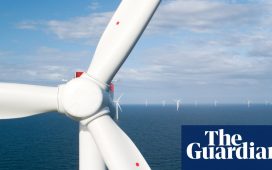Retirement was pretty idyllic for Mac and Debbie McKeever, who moved to Fort Mohave in Arizona for the desert views, starry nights and fresh air. The couple hosted cocktails by the pool and taco Tuesdays with their neighbors – an active bunch of Republican voting retirees with a penchant for gas-guzzling RVs and side-by-sides, and the unlikeliest environmental activists.
However, in late November 2023, the McKeevers found out that the local government, the Mohave county board of supervisors, was about to vote on a zoning proposal for a gas fired peaker plant less than 1,200ft (0.2 miles) from their middle-class neighborhood Sunrise Hills.
Peaker plants are designed to fire up to meet spikes in energy demand when people get home from work or during a heatwave. If approved the plant’s jet engine turbines would block the McKeevers’ view of the majestic Black mountains, while spewing carbon dioxide particulate matter, nitrogen oxides and sulphur oxides, as well as leaking methane, a potent greenhouse gas, into the atmosphere.
Mohave Electric Cooperative (MEC) and its umbrella organization, Arizona Electric Power Cooperative (Aepco), claimed this kind of plant is essential to avoid price increases and blackouts. And that the proposed gas fired peaker is the cheapest, cleanest, and most reliable option for their customers – and necessary to end their reliance on coal, they say.
At the board meeting in early December, several residents spoke passionately against building a toxic eyesore so close to their homes. Yet even more folks spoke in favor of the plant, with many repeating the utility’s talking points about affordability, avoiding outages and keeping emergency services running. It was approved by a 4 to 1 majority.
“Life was good. And then the peaker plant turned it into a miserable nightmare,” said Mac McKeever, a retired aerospace manager who helped lead the community’s “not in any neighborhood” campaign.
Over the next few months, the Sunrise Hills retirees – among them many climate crisis skeptics and committed fossil fuel proponents – uncovered a trail of misinformation that appear to suggest MEC and Aepco, which is developing and will own and operate the gas combustion turbines, were at times opaque as they sought to fast track approval and circumvent closer scrutiny. MEC/Aepco “categorically deny” any effort to intentionally mislead anyone.
The retirees organized and began fact-checking and calling out claims about affordability, outages and low pollution made by MEC and Aepco in the glossy brochure and during public meetings.
It turned out that with a capacity of 98 megawatts, the two-turbine proposal fell just under the 100 MW limit that requires a state mandated comprehensive environmental review of impacts such as emissions, noise and water consumption by an expert committee at the state utility regulator, the Arizona corporation commission (ACC). Yet the utility has openly discussed plans to eventually double the size of the plant.
It also turned out that many of the county residents who spoke favorably of the plant in front of the board were in fact MEC employees and board members.
And while the Mohave gas fired peaker may be cleaner than coal or diesel plants, gas remains much more harmful to air quality and the climate than renewable energy options – which thanks to recent scientific advances are now, in many cases, as or more cost-efficient and reliable (with battery storage and grid connectivity) than fossil fuel-based sources.
“They thought we were idiots, but we’re educated, retired citizens with nothing else to do but go to battle with them,” said Mary Arciniega, who has asthma and COPD and was among a core group who spent hours sharing research and strategizing in McKeever’s garage.
“We are not activist types, but we educated ourselves and became a force to be reckoned with,” added Deb McKeever, 66, who suffers from asthma, which can be exacerbated by the toxic chemicals spewed out by gas plants.
Yet in Arizona, and many other US states, despite the availability of cheaper and cleaner options, gas expansion is being aided by local and national campaigns against renewables.
The Mohave peaker plant was voted on by the board just weeks after it voted unanimously for a temporary moratorium on renewable energy projects amid claims the county was being blighted by federally funded corporate solar farms to generate green energy for California and Nevada – and that solar would exacerbate current water shortages.
While gas-fired plants are more water efficient than coal-fired electricity, they still use much more than solar, which requires virtually no water after construction.
And while the moratorium excludes local utilities including MEC, it appears to have sown confusion among residents – and even the board. “I will continue to support gas-powered peaker plants as long as we have a moratorium on alternative energy,” said Jean Bishop, one of the five board supervisors, addressing MEC directly at a meeting in April.
MEC’s proposal for new gas infrastructure in one of the US’s sunniest swathes of desert, appears to be part of a broader effort to keep Arizona dependent on fossil fuels for decades to come. This is despite the state facing a multitude of worsening climate impacts including extreme heat, drought, floods, wildfires and water scarcity.
Proposals for around three dozen new gas turbines are currently making their way through the state permitting pipeline, according Sandy Bahr, director of the Grand Canyon Chapter of the Sierra Club. “We’re seeing a rush for gas when we should be getting off fossil fuels. Mohave is just the tip of the iceberg.”
This includes proposals by several utilities that fall just under 100 MW that will avoid oversight by the independent power plant and line siting committee, which is part of the ACC, the state utility regulator.
The committee requires a certificate of environmental compatibility and provides the only forum for communities, experts and other interested parties like environmental and ratepayer groups to testify and challenge claims by the utility. Otherwise, residents are limited to making public comments in local air quality and building permit processes.
Last month, the committee rejected a brazen bid by the utility UniSource to exempt its proposed 200 MW methane plant from the CEC on the grounds it should be considered as four separate 50 MW power plants.
“The utilities claim they need to build more fossil fuels to get off fossil fuels, it’s absurd, but a talking point that’s repeated by lawmakers and commissioners who are ideologically anti-clean energy, anti-Biden and anti-green new deal,” said Autumn Johnson from Arizona Solar Energy Industries Association (AriSEIA), a trade group.
These claims hold weight in the Republican-controlled state legislature, where more than half a dozen anti-renewable bills have been tabled so far this year, in addition to multiple local ordinances restricting or halting renewables like a solar moratorium in Mohave county. Meanwhile, the Republican controlled utility regulator, the ACC, has implemented rules that create unfavorable conditions for rooftop and community solar – and recently voted to repeal the state’s renewable energy mandate, which requires utilities to obtain 15% of their power from clean energy sources by 2025.
This sets the state apart, as most other jurisdictions across the country are mandating utilities to source more electricity from clean sources. As of November 2022, 36 states and Washington DC had established a renewable energy goal, with a third of those requiring 100% clean electricity by 2050 or earlier.
The Mohave case also underscores the influence of misinformation, culture wars and local politics threatening to delay the US’s transition to renewable energy sources, which scientists say is essential to avoiding widespread climate catastrophe.
By mid-2023, there were at least 228 local bans and restrictions to renewable project across 35 states, in addition to nine state-level restrictions, that are so burdensome that they could have the effect of blocking a project, according to the Sabin center for climate change law at Columbia University Law School.
Blocking renewable energy like solar and wind is a top 2024 state legislative priority for the State Policy Network, a hub for affiliated pro-fossil fuels think tanks funded by right-wing and corporate donors.
“The hostility and misinformation about renewables is very significant and very hard to fight because it’s so easy to spread. It is like playing whack-a-mole in a post-data world where people – constituents and politicians – don’t care about the actual numbers because deep in their core they want to believe fossil fuels are cheaper and more reliable,” Johnson said.
Fort Mojave is an unincorporated town of 16,000 people in Mohave county, located on the eastern banks of the Colorado river, about 100 miles south of Las Vegas.
It’s a rural, predominantly white county where 75% of the population voted for Donald Trump in 2020 – the most Republican leaning place in the state. With almost 300 sunny days each year, the county is popular among retirees escaping colder climates, with sprawling new suburbs and RV parks scattered amid the desert plains and parched fallow fields.
The county is served by two monopoly utilities, MEC and UniSource, which currently include around 14% and 17% in renewable resources respectively, slightly lower than the national average. Despite favorable conditions (windy, wide-open spaces and sunny climate), the county has only a handful of small industrial solar farms, including a 5MW MEC facility located just behind the Sunrise Hills community.
In 2022, MEC purchased a large plot adjacent to the solar farm which has a gas pipeline running through it. The 15 acres section closest to the community was temporarily rezoned from residential to heavy manufacturing and industrial in 2018 by the board – for a rock crushing venture that never materialized. The board should have reverted the land back to residential use after two years, but didn’t due to a backlog, according to a county spokesperson. This oversight meant MEC acquired the plot with the industrial zoning intact.
In 2023, MEC submitted an application to build an “energy park” – which residents interviewed by the Guardian assumed would be an extension to the solar farm. MEC first had to get the green light from the county’s planning and zoning committee in November – which it did unopposed as Sunrise Hill residents were still unaware of the project.
The county did publish notices in local newspapers and taped a small cardboard sign about a new energy facility on a wooden stake on the site perimeter along a windy dirt road, thus fulfilling its notification obligations but which few people saw. No residents were informed because state law only requires household holds living within 300ft be notified, which experts have long criticized given the known environmental and health risks associated with power plants.
Patrick Ledger, Aepco’s CEO, told the Guardian that all county procedures were followed and rezoning is one step in a much broader, longer process with opportunity for public comment. He also said that utility staff and board members were also community members who had the right to participate in the December board meeting but that “MEC and AEPCO personnel and board members are happy to identify themselves in the future.”
Only one supervisor, Ron Gould, who represents Fort Mohave, voted against the gas peaker plant in December. “They tried to game the permitting system, and there is at least an appearance of impropriety. A residential area is a terrible place for a power plant. MEC told me that it would be my fault if energy prices go up.”
Gas powered peaker plants are a very expensive and dirty way to produce electricity, which contribute disproportionately to greenhouse gasses like methane and CO2. They are disproportionately located in low-income neighborhoods, communities of color, and areas already overburdened by pollution and climate impacts.
It is fair to say that the climate emergency is not a priority for Sunrise Hill residents.
The community’s main concerns center around quality of life issues like noise, light pollution and water scarcity, as well as safety (fires and explosions at the plant and pipelines), declining property values and air quality – especially given many of the retirees have respiratory and cardiovascular diseases and include some cancer survivors.
“I am not against gas, just the location. It’s clear they’re trying to circumvent the process,” said Kelly Refvem, whose corner property is closest to the proposed plant.
As soon as they got wind of the gas plant, concerned residents contributed resources – time, money and expertise – and the “not in any neighborhood” campaign group took out newspaper adverts and billboards against the project. MEC countered with more advertisements and billboards, claiming the plant was necessary to power fire stations, cooling centres and hospitals. At one meeting, Ledger, Aepco’s CEO, promised to build no more than four turbines if the community would back down – which would bring the project close to 200 MW.
He has also claimed that the plant’s energy would stay “local”. The project brochure states that “increasing MEC’s local generation resources can allow us to provide power to emergency locations … in the event of a massive outage such as 2022 Labor Day”.
The Labor Day outage was caused by storm winds taking out 50 MEC’s power poles and a transmission connection, not insufficient energy supply. It is impossible to guarantee that power from peaker plant will stay local, given that the entire western US is part of an interconnected grid.
Ledger said MEC is interested in developing a micro-grid to serve during disruptions.
Peaker plants make most of their money by being “on call”, ready to fire up and feed electricity into the grid with minimal notice – at a premium cost.
MEC, like Aepco, is a non-profit member-owned co-op. Tyler Carlson, MEC’s chief executive, received $1.6m in compensation in 2022, while Ledger received $830,000, according to IRS filings.
Still, the community refused to back down, and in mid-April MEC/Aepco convened an invite-only meeting at a fire station a few miles down the road from Fort Mohave in Mohave Valley to inform residents that they were now also considering a site for the peaker plant in their community. The local fire department, which would get the biggest tax windfall, spoke in favor of the plant.
“We got the same propaganda as Fort Mohave, that this was the most clean, efficient, economic option, but they have no credibility.” said Roy Hagemeyer, senior pastor at the Way Christian church in Mohave Valley.
While there is no densely populated neighborhood like Sunrise Hills next to the proposed site, there are two schools and hundreds of homes within a 3-mile radius – the minimum distance for minimizing harm to marginalized communities, according to the Environmental Protection Agency. It’s only 800ft from tribal lands belonging to the Fort Mojave Indian tribe.
According to Ledger, the gas plant, alongside planned solar farms – which are contingent on Aepco receiving federal grants – will “improve reliability, address energy market shortages, and result in significant emission/carbon reductions”. It was not disingenuous to claim the peaker would prevent outages, and that they intended to help MEC develop a micro-grid to serve during power disruptions, he added.
“We strongly believe Aepco’s project will benefit not only MEC members, but the entire community, including the tribe. We continue to investigate all sites we have identified, as well as others that are suggested,” said Ledger.
Sandy Bahr from the Sierra Club said: “This project should not be in anyone’s backyard; it makes no sense on any level. It highlights loopholes and weaknesses in our regulatory system – and the anti-solar fever which is starting to have a chilling effect.”










